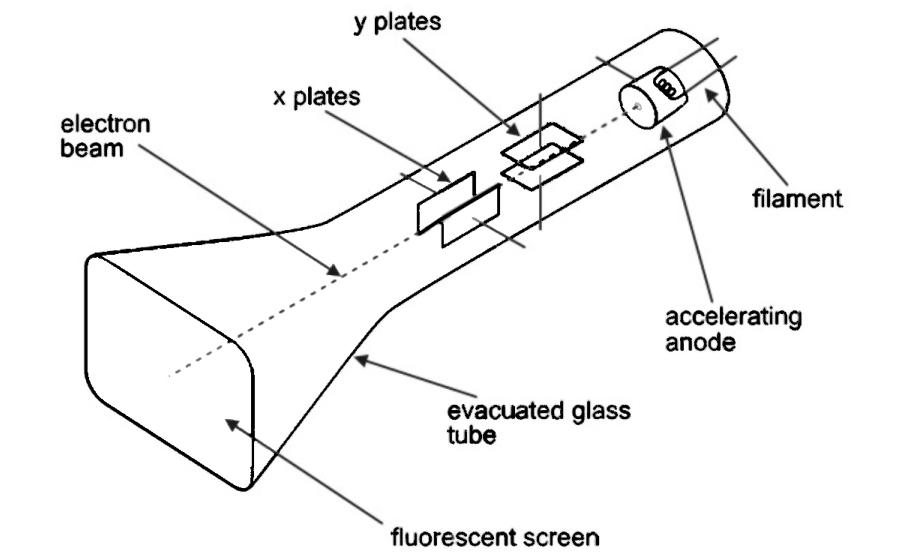
Name the three main parts of the cathode ray tube.
Answer
482.4k+ views
Hint: In this question we have been asked to name the three main parts of the cathode ray tube. Therefore, to answer this question, we shall first discuss the construction of cathode ray tubes. We shall then discuss the main parts of the cathode ray tube along with their working and the need in the tube. The television set in every household has a cathode ray tube that displays the images.
Complete step by step answer:
A cathode ray tube is a vacuum tube in which images are produced when an electron beam strikes a phosphorescent surface. A Cathode ray tube is made of the electron gun assembly, the phosphor viewing surface, and the glass envelope. A heated cathode surrounded by a metal anode makes the electron gun assembly.

The first important part of the cathode ray tube is the heated metal cathode also known as the electron gun. The heat is supplied to the cathode which gets the electrons heated up. These electrons then start ejecting as a stream of negatively charged electrons which later accelerates towards the phosphor screen.
The second important part of the CRT is the phosphor screen. The function of this fluorescent screen is to convert electrical signals into visual patterns.
The third import part of the CRT is the deflecting system. The function of the deflector system is to deflect the electron beam horizontally or vertically. Therefore, it is also known as electron beam deflector.
Note:
J.J Thompson carried out an experiment with the cathode rays showing that all atoms contain tiny negatively charged particles. When the electron beam hits the phosphor screen, the phosphor sparks or emits light. In Thompson’s experiment, the cathode ray deflected away from the negatively charged electric plates and attracted towards the positively charged electric plates. This helped him prove that cathode rays were composed of tiny negatively charged particles.
Complete step by step answer:
A cathode ray tube is a vacuum tube in which images are produced when an electron beam strikes a phosphorescent surface. A Cathode ray tube is made of the electron gun assembly, the phosphor viewing surface, and the glass envelope. A heated cathode surrounded by a metal anode makes the electron gun assembly.

The first important part of the cathode ray tube is the heated metal cathode also known as the electron gun. The heat is supplied to the cathode which gets the electrons heated up. These electrons then start ejecting as a stream of negatively charged electrons which later accelerates towards the phosphor screen.
The second important part of the CRT is the phosphor screen. The function of this fluorescent screen is to convert electrical signals into visual patterns.
The third import part of the CRT is the deflecting system. The function of the deflector system is to deflect the electron beam horizontally or vertically. Therefore, it is also known as electron beam deflector.
Note:
J.J Thompson carried out an experiment with the cathode rays showing that all atoms contain tiny negatively charged particles. When the electron beam hits the phosphor screen, the phosphor sparks or emits light. In Thompson’s experiment, the cathode ray deflected away from the negatively charged electric plates and attracted towards the positively charged electric plates. This helped him prove that cathode rays were composed of tiny negatively charged particles.
Latest Vedantu courses for you
Grade 10 | CBSE | SCHOOL | English
Vedantu 10 CBSE Pro Course - (2025-26)
School Full course for CBSE students
₹37,300 per year
Recently Updated Pages
Master Class 9 General Knowledge: Engaging Questions & Answers for Success

Master Class 9 English: Engaging Questions & Answers for Success

Master Class 9 Science: Engaging Questions & Answers for Success

Master Class 9 Social Science: Engaging Questions & Answers for Success

Master Class 9 Maths: Engaging Questions & Answers for Success

Class 9 Question and Answer - Your Ultimate Solutions Guide

Trending doubts
Give 10 examples of unisexual and bisexual flowers

Draw a labelled sketch of the human eye class 12 physics CBSE

Differentiate between homogeneous and heterogeneous class 12 chemistry CBSE

Differentiate between insitu conservation and exsitu class 12 biology CBSE

What are the major means of transport Explain each class 12 social science CBSE

a Tabulate the differences in the characteristics of class 12 chemistry CBSE




